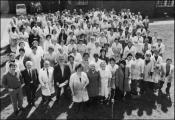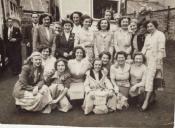Browse the interviews
Sorted by factory location
Cardiff: Peggy Anne
VSE011 Maisie Taylor, Horrock's, Cardiff;Peggy Anne, Cardiff
Maisie’s mother worked in Curran’s Factory during the war. Maisie left school at 15 (1948/9) and started in Horrocks - called Peggy Ann at the time, making children’s dresses. Horrocks took over – making bedding, dresses etc. The company had other factories and they had sales of all their products. Stayed there 10 years. Describes location of factory. Different world. Very brash women. Noise made her talk loudly. She worked on the special bench doing lots of tasks, then on the overlocker, finger caught on buttonholing machine. Periods affected her – restroom. This affected production of line. Looking after their machines. On special bench – more skilled. Describes processes. Cold and bending over machine affected her back. Xmas party for children – choosing presents. Piecework – holding back when being timed e.g. one dress in 4 minutes worth 50p. . Sewing and altering clothes at hometo supplement income. Supervisors ‘like our mums’. Music broke the monotony. Story about working late – fog and no lighting on road. Going out in Barry and Cardiff. Mentions Irene Spetti (stage name – Lorne Lesley when in factory, married to David Dickinson) and Rose Roberts – talented cabaret singers who worked in Horrocks. Tells story about supervisor (Miss Grünfeldt) offering to make her wedding dress in the factory. She still has the dress. Left factory because pregnant (1959.) Later worked in caffes etc. Factory - ’Best time of my life’Cardiff: Polythene Factory
VSE072 Marguerite Barber, Polythene Factory, Cardiff;Stamina, Cardiff
Marguerite left school at 15 (1958) and started in the Stamina Factory, putting buttons and hooks on overalls and the buttonholes. These were industrial work-wear. Permission to go to the toilet. She stayed there less than a year. Machinists on piecework but she wasn’t. She bought a wind-up gramophone with her money. She moved to the Polythene Factory and stayed there 9 years. She sealed bags there – cutting them out, sealing them and putting them in bundles. It was like a family. She talks of condemning the houses in Loudon Square in Butetown. Canteen and one toilet. Complaints about cold (but too hot in summer) but no strikes. Outings by boat once a year. Day before Xmas – everyone went to the pub together at 12 o’clock. She left when 7 months pregnant. . Later she was a hotel chambermaid.Cardiff: Ralph Mathers garment factory
VSE071 Veronica (Vera) Diane Lena Battle, JR Freeman's Cigar Factory, Cardiff;Ralph Mathers garment factory, Cardiff;Garment factory, Cardiff
Vera’s father was a renowned jazz musician – she outlines her background and his career. Vera left school at 14 (1948) and started in the sewing factory, sewing buttons and canvas in the lapels of men’s jackets. She moved to the cigar factory in Clive Street, annual trip to London. She took the cigars down the cellar and stacked them to dry out. Because the factory moved to Penarth Road she went to work in a tailoring factory making women’s clothes. She was on the overlocker and the buttonholes. They sang. There were a lot of Greek girls there. They were the best tailors She names some of the workers. She had clothes made for her daughters there. She moved to Toulouse with her prospective husband but returned and he went back to America. She was also a dancer who performed in the chorus of an American Negro show and on tour (London and Scotland etc.). She has worked in a primary school too.Cardiff: Silouette Underwear
VSE048 Mary Brice, Guest, Keen and Nettlefold (GKN);Silouette Underwear, Cardiff
After leaving school at 14 Mary had several jobs (café, David Morgan’s, Welsh Mills etc) before getting married and staying home with the children for ten years. Then she did agency work before joining the wages department at Silhouette’s. The factory girls were very sociable and included her. The factory made lingerie and swim wear. There was a nurse there who dealt with personal problems and minor injuries. The wages were basic + piece work. The factory was run from Shrewsbury. She remembers the huge support the factory girls gave to an unmarried mother. There were special buses from Barry. She organised chocolates for the workers at Christmas. She moved to work for the Electricity Board after four years.Cardiff: Slumberland
VSE079 Madeline Sedgwick, Slumberland, Cardiff;Spillers and Bakers, Cardiff;Lionites Spectacles Cases, Cardiff;Currans, Cardiff
Madeline left school at 14 (1943). She talks of sheltering under Cardiff castle during air raids and the dangers. She worked as a hairdresser and then she started in Curran’s in 1948. They had a reputation for being racist. She talks of her experience with Littlewood’s. She worked in enamelling, making chamber pots (their handles) and mugs. She talks of different areas of Cardiff. She bought clothes and fish scrumps and went to dances with her own money. She only stayed there three months and she went to Spillers, on the flour and dog biscuits. They got a big machines and changed to working shifts. Rats. Small factory. Unloading grain from the ships downstairs. They wore turbans. She liked the sewing machine. Singing and talking. She left because of the shift work and moved to Slumberland – it was dusty there. She describes a visit to London. She describes her work and says that the company’s Paisley (Birmingham) workers were paid more than their Welsh ones. In winter her fingers would bleed from the fibres and the cold. She hit her leg and left. Then on to Fletcher’s but in the office – dressed smartly, answered the telephone and invoiced. She tells the story of challenging the boss of Slumberland about working until 6 on Fridays.Part of this interview is available as an audio file
Cardiff: Spillers and Bakers
VSE079 Madeline Sedgwick, Slumberland, Cardiff;Spillers and Bakers, Cardiff;Lionites Spectacles Cases, Cardiff;Currans, Cardiff
Madeline left school at 14 (1943). She talks of sheltering under Cardiff castle during air raids and the dangers. She worked as a hairdresser and then she started in Curran’s in 1948. They had a reputation for being racist. She talks of her experience with Littlewood’s. She worked in enamelling, making chamber pots (their handles) and mugs. She talks of different areas of Cardiff. She bought clothes and fish scrumps and went to dances with her own money. She only stayed there three months and she went to Spillers, on the flour and dog biscuits. They got a big machines and changed to working shifts. Rats. Small factory. Unloading grain from the ships downstairs. They wore turbans. She liked the sewing machine. Singing and talking. She left because of the shift work and moved to Slumberland – it was dusty there. She describes a visit to London. She describes her work and says that the company’s Paisley (Birmingham) workers were paid more than their Welsh ones. In winter her fingers would bleed from the fibres and the cold. She hit her leg and left. Then on to Fletcher’s but in the office – dressed smartly, answered the telephone and invoiced. She tells the story of challenging the boss of Slumberland about working until 6 on Fridays.Part of this interview is available as an audio file
Cardiff: Spirellas Corset Factory
VSE080 Margaret Gerrish, Cora Garment Factory, Pengam;Spirellas Corset Factory, Cardiff;JR Freeman's Cigar Factory, Cardiff
Margaret talks of her father’s unionism NACODS and of leaving school at 13-4 (1944-5). She started working in a boarding school in Yeovil and then returned to Wales. She worked in Freeman’s. They travelled there from Tredegar by train. It was a new world. She saved with a provident cheque from her wages. The work was about earning money. Radio and singing. Shirley Bassey used to work there. Before Freeman’s she says she worked in Spirella’s. She had been apprenticed at The tailoring shop in New Tredegar- Parry’s. She didn’t go into the factory but did corset fittings for people in their homes. She had a skirt and jacket made for herself at Spirella’s. In c.1949-50 she went to Cora’s, making clothes for M&S and began in the cutting room. Supervisors were sent to Leicester to train. Then a new supervisor who began sacking workers. She was on examining and because one whole batch was bad he sacked them all. The union stood by them and they had their jobs back. After getting married she didn’t work in a factory.
Cardiff: Stamina
VSE072 Marguerite Barber, Polythene Factory, Cardiff;Stamina, Cardiff
Marguerite left school at 15 (1958) and started in the Stamina Factory, putting buttons and hooks on overalls and the buttonholes. These were industrial work-wear. Permission to go to the toilet. She stayed there less than a year. Machinists on piecework but she wasn’t. She bought a wind-up gramophone with her money. She moved to the Polythene Factory and stayed there 9 years. She sealed bags there – cutting them out, sealing them and putting them in bundles. It was like a family. She talks of condemning the houses in Loudon Square in Butetown. Canteen and one toilet. Complaints about cold (but too hot in summer) but no strikes. Outings by boat once a year. Day before Xmas – everyone went to the pub together at 12 o’clock. She left when 7 months pregnant. . Later she was a hotel chambermaid.Cardiff: Vandervell Productions
VSW061 Eirlys Lewis, Vandervell Productions, Cardiff;Mettoys, Fforestfach;Alan Paine, Ammanford;Pullmans Flexolators, Ammanford
Eirlys left school at 15 (1964) and started in Pullman’s Flexolators, making car seats, springs etc. Everyone got on there. Smoking while working. Paying Union fees but not the % to the Labour Party. Dirty work. One dangerous job because of acid - coating things with paint. Teasing young workers – fetching elbow grease. She learned to live there. Lots of swearing. She heard about the Aberfan disaster when in the Alan Paine factory. She made a mistake going there (stayed only 9 months); then to Mettoys for 3 years (1966-9) on the assembly making toy cars. Some of the girls were very fit. Then she worked on a farm for 2 years. In 1972 she went to Vandervell Products, Splott, Cardiff – for 10 years making car and lorry parts. They opened a new department (c.1976) and girls now did the same jobs as the men. One man asked for her help. Interviewed by the BBC about her job as a mechanic. Social club – she played ninepin bowling. Good money. One woman lost her fingers in a machine – compensation. In 1976 there was a strike about being too hot – she refused to join because she believed the company was doing its best. She was sent to ‘coventry’ for 4 months. One woman objected to her speaking Welsh – answered her back. Girls not allowed to work on night shift. Then she got married and worked for periods in Llangadog milk and Carmarthen cheese factories.
Cardiff: Western Shirt Company
VSE077 Jeanette Groves, Western Shirt Company, Cardiff
Jeanette left school at 14 (1946) and started in the sewing factory, where her mother used to work. She started in the cutting room then she became a machinist. Needles through fingers, scissors in her eye and one woman scalped (in her mother’s time) Getting to work by bus or bike. Wearing rollers to work but putting make up and combing hair at the first break. Some made their own clothes during lunch time. Had to unpick if there was a mistake and they helped one another or lose money. Their aim was a dozen skirts an hour @ 1shilling a dozen. Out around Cardiff during lunch break. A crowd went out in the evenings – dancing. They waited for natural light before making dark clothing. They made shirts and pyjamas only. Teasing the one mechanic by interfering with their machines. Annual trips and issued with cigarettes. She left after 3 years because she had TB. She married and moved to Bristol where it was cured eventually.
